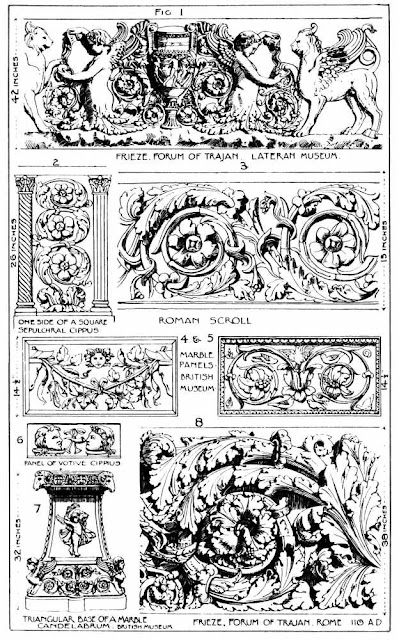Rome, founded by Romulus, B.C. 783, became by successive wars and conquests the mistress of the world, absorbing the arts and the architecture of the Etruscans B.C. 567, the Samnites B.C. 340, and of Corinth and Carthage B.C. 146.
_ _ _ _ _
Еxcerpt from the book: A Manual of HISTORIC ORNAMENT TREATING UPON THE EVOLUTION, TRADITION AND DEVELOPMENT OF ARCHITECTURE AND OTHER APPLIED ARTS. PREPARED FOR THE USE OF STUDENTS AND CRAFTSMEN.
BY RICHARD GLAZIER, Associate of the Royal Institute of British Architects; Head Master of the Municipal School of Art, Manchester, LONDON: 1899
Original Title of the chapter - ROMAN ORNAMENT.
_ _ _ _ _ _
From these varied sources arose the style termed Roman, assimilating and adopting the column and the horizontal entablature of the Greeks; the arch, the vault, the mural paintings and the decorative use of bronze and the terra-cotta of the Etruscans, with the sculpture, ornament, mosaics and coinage of the Greeks and Carthaginians. These varied arts were assimilated and perfected by the Romans during the period B.C. 100 to 337 A.D.
Roman ornament is the continuity of the Greek and Etruscan styles, consisting of the anthemion, the acanthus and the scroll; the Romans using these forms with greater exuberance and elaboration, together with bold and vigorous carving, yet lacking the simplicity, refinement and graceful contour of the Greek and Etruscan forms.
Roman ornament consists largely of continuous spiral lines clothed with cups and sheaths of acanthus foliage, the various spirals terminating in a rosette. These main spirals are frequently interwoven with fine curved or spiral lines, clothed with acanthus or other foliation, such as the vine, olive and ivy. Birds and reptiles and cupids, and the chimera or griffin (fig. 1) are often interspersed with the ornament, thus giving that largeness of mass and contrast of form which is so characteristic of Roman art.
The Thermæ, or baths and public buildings, displayed fine decorative ceilings, having deep sunk panels called Lacunaria; or coffers, square, hexagonal or octagonal in form, with a center rosette in high relief and the border moldings of the coffers being enriched with the egg and dart or the water leaf. These exhibit an effective treatment of molded surfaces. The ceilings of the tombs and palaces were in many cases ornamented with circular and square panels, richly decorated with arabesques or mythical figures, and cupids in low relief of fine stucco; the moldings or divisions in higher relief, and having the water leaf or the egg and dart enrichment (Plate 9.)
The architectural frieze and the sepulchral urn and sarcophagi of this period were often decorated with festoons (figs. 4 and 5, plate 9), and were supported by cupids or by candelabra (plate 9), or by the skulls of oxen, as on the frieze from the Temple of Vesta at Tivoli, here given, which is no doubt a survival of the sacrificial custom of worship.
Тhe architectural basilica and forum of Trajan, erected A.D. 114, by Apollodorus, a Greek of Damascus, was of the utmost magnificence, the remains attesting to the skill and artistic craftsmanship of the Romans. Apollodorus also erected the marble column of Trajan, having a rectangular pedestal 18 feet high, and richly sculptured with the dresses, armour and standards of the Roman army. This pedestal supports a column of the Tuscan order of architecture 97¼ feet high and 12 feet in diameter, enriched with a series of spiral bands, having bas-reliefs representing the successive events of the Dacian War by the Emperor Trajan.
This magnificent and well preserved relic of antiquity furnishes a complete epitome of the costumes and the arms and armor of that period. Another well-preserved column, similar to that of Trajan, was erected in Rome by Marcus Aurelius A.D. 174, the subjects of its reliefs being the war with the Marcomans. Large marble urns, or Tazzas, enriched with Bacchanalian figures, surrounded with foliage and birds and animals; magnificent tables, chairs, couches, and candelabra, of bronze, enriched with silver damascening, together with the choice remains of sculpture and mosaics, all indicate the luxuriousness and love of magnificence of the wealthy Roman citizens.
In Roman architectural ornament we see the most powerful modelling combined with the use of the continuous scroll growing from a nest of foliage, repeated in their painted decorations (see Pompeian). This elaboration of the typical Greek ornamentation and the rounded serrations of the Acanthus, forms the chief characteristic of Roman ornament, which is wonderfully bold, and vigorous in conception and execution, but deficient in the refinement and delicacy of Greek art.















Social Plugin